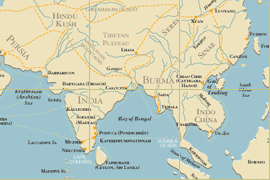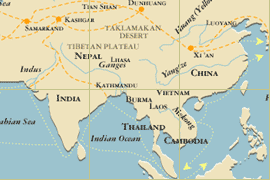   
Overland routes
The trade conducted along the ancient overland roads connecting East and West, known popularly as the Silk Road (a term coined by the nineteenth-century German geographer Ferdinand von Richthofen), ran from Xi'an in China to the Mediterranean port cities of Antioch and Tyre. The latter ports linked the Near East with Rome and the West. An extensive network of roads connected India with various points on these trading routes and to other overland trails leading to Burma (Myanmar) and mainland Southeast Asia. Routes also went east from Xi'an, connecting China with the Korean peninsula. Some routes were well developed and relatively free from bandits, and while others might have been quicker, they were not as safe and had fewer oasis towns to offer shelter from the harsh elements. However, very few merchants traversed the full length of the various trails that make up the Silk Road; most covered a section, selling their wares and then returning home. Goods that moved great distances therefore changed hands as in a relay, and the transportation of items from one end to the other may have taken as long as one year.
Despite the name, much more than silk was transported along these great connecting routes. For example, paper, furs, tea, lacquered goods, and ceramics traveled from China east, while products such as ivory, glass, and spices such as frankincense and myrrh went from west to east. All went overland by way of caravans consisting of anywhere from one hundred to one thousand camels, each animal loaded with as much as five hundred pounds of goods. Sometimes, troops of archers were hired as escorts to defend the caravans from bandits.
Although very few Roman coins have been found in Pakistan, Roman sources suggest that the main path of the western Silk Road during the first two centuries C.E. passed through central Asia to the Indus Valley. Going directly to the seacoast along the Indus River or detouring through the city of Mathura, it connected with the Roman world by sea. Indian Buddhist missionaries, both those practicing "foundational Buddhism" and Mahayana Buddhism, were traveling with the caravans by the first century C.E.; they were responsible for taking Buddhism to China during the first century and for the religion becoming predominant in the central Asian states until the tenth century, when Islam prevailed.
Back
|

